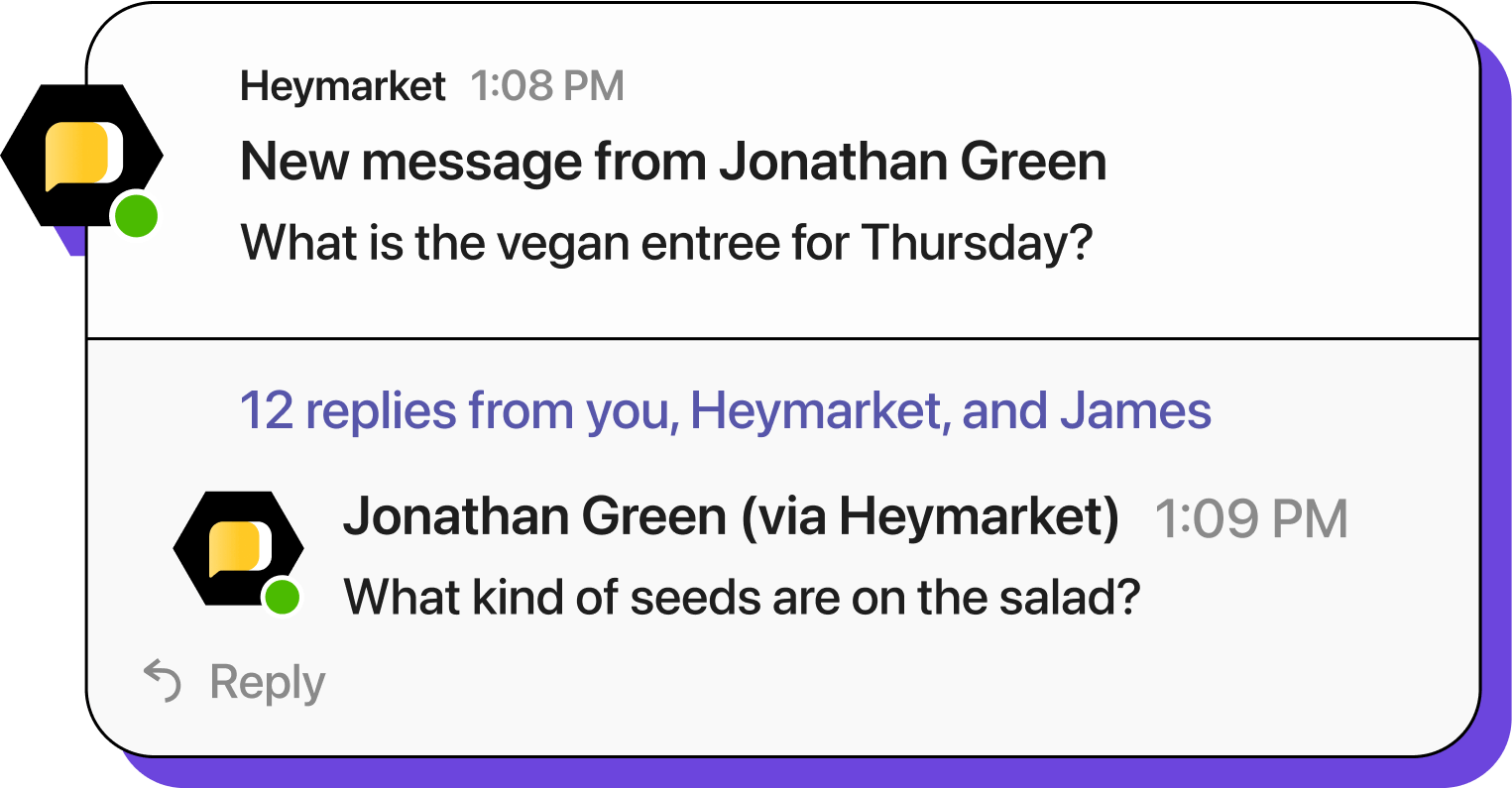How to use Microsoft Teams to send SMS in 4 easy steps
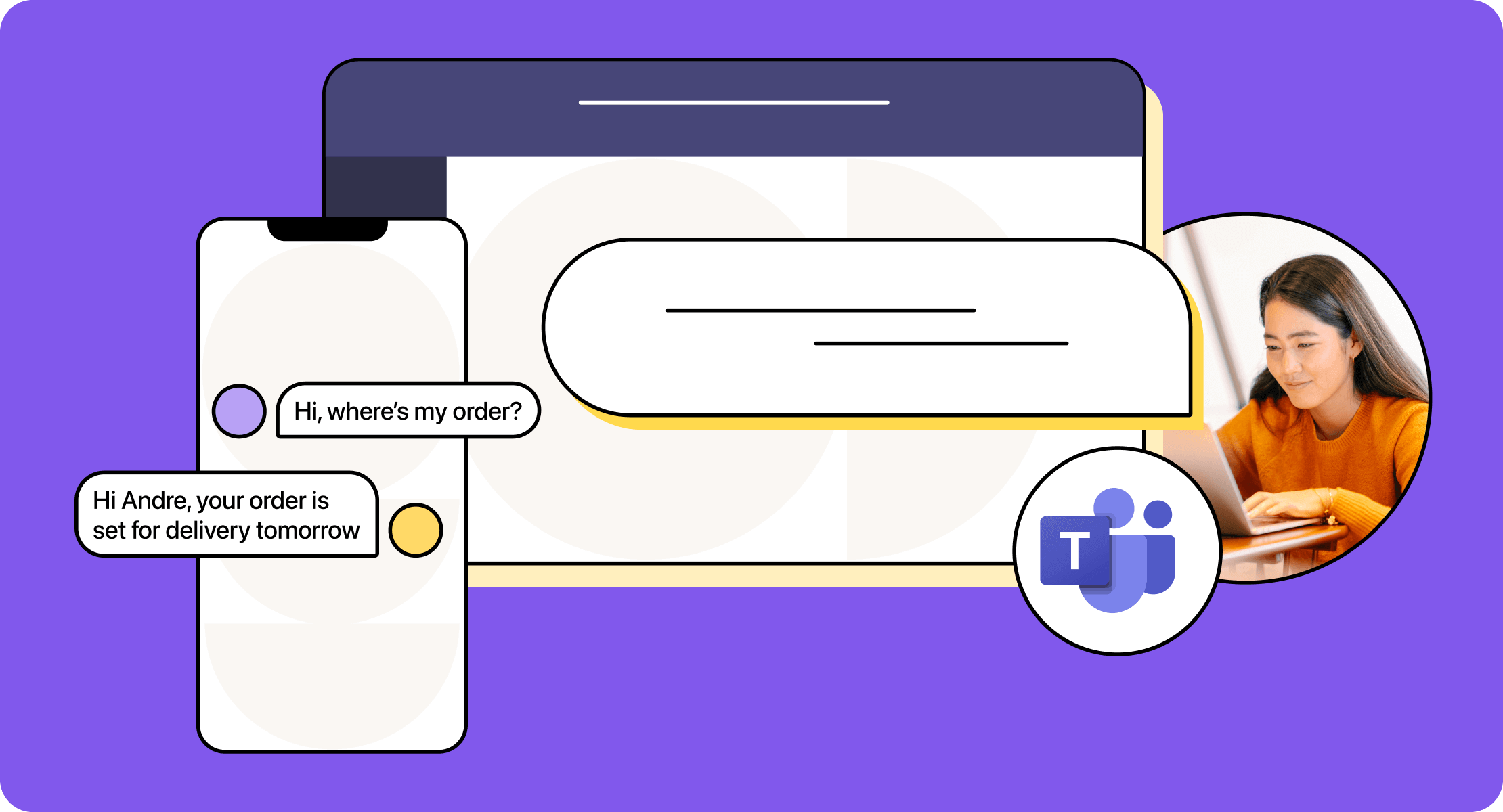
With over 320 million users, Microsoft Teams is one of the top communication tools for businesses. It’s great for chatting with teammates, collaborating and sharing documents, jumping into voice calls, and hosting face-to-face meetings, helping to streamline communication between team members.
However, as customer demand for texting with businesses has grown, so has businesses’ interest in messaging customers right from Teams. And it makes sense – if your team already uses MS Teams internally, adding external communication means members can field customer messages alongside internal messages without leaving the app, enabling faster replies.
As a result, Microsoft Teams created its own native SMS feature, participant chats, that offers limited text support. These chats are a quick and easy way to start texting customers from Teams, but if you decide you want to add more channels or integrate texting into your workflows, an SMS integration for Microsoft Teams might be a better fit.
Keep reading to learn the different ways you can send a text message through Microsoft Teams and learn which is best for you.
How can you send SMS from Microsoft Teams?
Yes, you can send SMS from Microsoft Teams using Teams’s native participant chats or with a third-party integration that adds advanced texting features to MS Teams.
Teams participant chats
SMS chats are Microsoft’s solution for native Microsoft Teams messaging with customers and contacts. This feature allows you to send messages from Teams to external contacts instead of just app contacts, which they can reply to directly via SMS or join the conversation in Teams using the link attached to your initial message.
However, Teams routes each chat message through the app before delivering it to the recipient, which means texts come from a short code number (in the format 12-345) instead of your business’s standard 10-digit number. In some cases, customers may hesitate to respond to messages from unfamiliar numbers, potentially leading to delayed responses and slower communication.
Participant chats also only enable SMS, which limits how well you can maintain your brand voice, personalize the interaction for better engagement, and provide complete information to contacts effectively without using another channel.
Third-party Microsoft Teams SMS integrations
Unlike Microsoft’s native participant chats, third-party integrations for MS Teams allow you to do much more with your text channels. You can use MMS instead of SMS, choose your own number or get a new one, route chats to the right agent, automate workflows, and much more. This enables texting throughout the customer journey to help improve communication speed and quality.
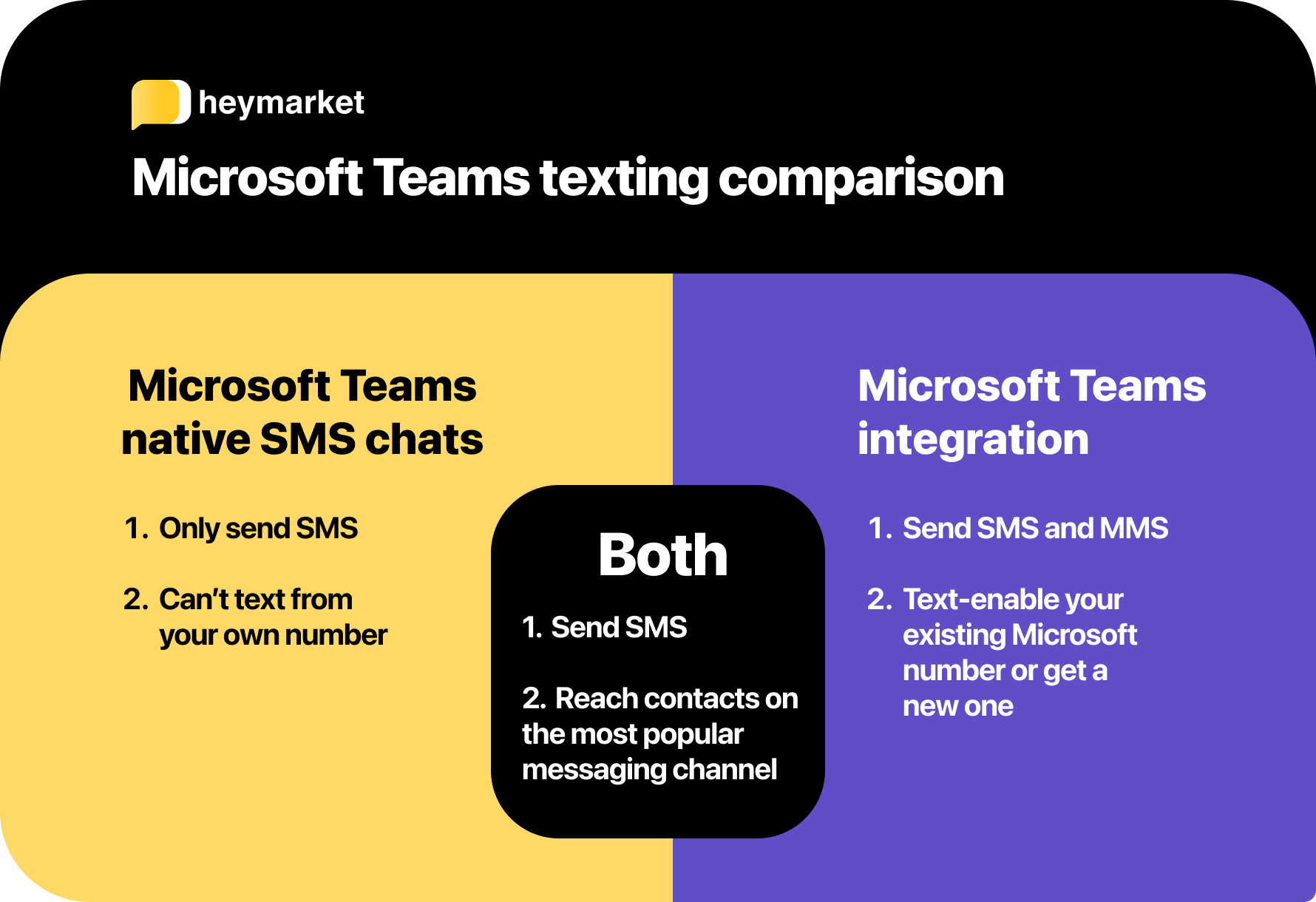

Want to start sending texts from Microsoft Teams? Check out Heymarket’s Microsoft Teams SMS integration.
Learn MoreHow to send a text through Microsoft Teams
If you want to effectively communicate with customers, you need the ability to text from Microsoft Teams. You can choose between using native participant chats or a Teams SMS integration, but a third-party integration for Teams is most likely to have all the features you need.
However, participant chats may work for certain businesses. If you’re one of them, here’s how to start texting:
- Select ‘new Chat’ in Teams
- Enter the recipient’s phone number in the ‘To:’ field
- Assign the contact a name for the conversation (only visible to you)
- Start the conversation to send the invite
If you’re looking for advanced functionality and more control over your communication, here’s how to send texts with a Microsoft Teams SMS integration.
Step one: choose a third-party messaging app
Before you send your first text through Microsoft Teams, you need to choose the right third-party messaging integration from Microsoft’s AppSource.
Third-party SMS integrations come in two forms: apps that connect to Teams and integrations that become part of Teams’s interface directly.
Many SMS apps require you to send texts through their SMS platform instead of directly through Teams, which means switching between apps and windows. These added steps hurt productivity and can cause distractions that delay customer service replies.
For maximum productivity, look for a messaging integration that allows you to:
- Start new texting chats from within a Microsoft Teams channel
- Receive and reply to texts from within a Microsoft Teams channel
- Receive and reply to messages from popular apps (e.g., Facebook Messenger) from within a Microsoft Teams channel
- Use pre-made message templates from an integration-specific Tab within Microsoft Teams
- Text-enable your own phone number, including your Microsoft Teams number (if applicable)
- Import contacts or integrate with your other apps
Once you’ve identified a tool that offers these features, you can start setting up your Microsoft Teams SMS integration.
Step two: configure the messaging integration
Configuring a messaging integration should only take an hour at most with help from a step-by-step guide. In this phase, what you’re doing is ensuring that both platforms are set up to share data and take actions in one another.
To configure the messaging integration, you will need to:
- Download the third-party messaging app within Microsoft Teams. The Microsoft Teams AppSource marketplace offers multiple direct SMS integrations, like Heymarket.
- Set up the third-party messaging app (if you haven’t already done so). This process will likely include sharing your basic information (like email address and company name), as well as authenticating this information.
- Confirm the integration in both platforms. Within your business SMS platform, you should see a new screen that allows you to set up the Microsoft Teams SMS integration. You’ll follow the guided process, which asks you to begin an authentication process within Microsoft Teams SMS.
- Decide which business texting inbox will map to which Microsoft Teams channel. If you have multiple SMS inboxes for multiple teams (like Sales and Customer Service) you will have to make this decision. You’ll also need to decide on the Microsoft Teams channel these rerouted messages will go to.
- Map your business SMS inbox to your designated channel. Now that you’ve made that decision, you can proceed with the setup process. On the Microsoft Teams integration page within your business SMS platform, choose your inbox and Microsoft Teams channel.
- Test the integration. Finally, your business SMS platform will send a message to your Microsoft Teams channel. If you set up the integration properly, you’ll receive a text within your designated Microsoft Teams channel.
In this step, you’ll notice that both Microsoft Teams and your third-party messaging app require a lot of authentication. This is a good thing: since you will be texting customers and business partners, you’ll want to ensure that there are security measures in place to protect their personally identifiable information (PII).
Step three: learn basic texting features
Before you send a text to a customer or business partner, you’ll want to learn how to use basic texting features, exploring how exactly they work within Microsoft Teams.
All third-party messaging apps don’t offer the exact same features. They’ll allow you to text in different ways. For a platform like Heymarket, for example:
- You have to mention the bot @Heymarket to text a phone number.
- You can start a new SMS conversation in Teams by @mentioning Heymarket, choosing Heymarket from the hint pop up, then choosing the selected action to start a conversation. The formula looks like this:
- Template: @Heymarket text [Phone] [Text Message]
- Full Example: @Heymarket text 1(415)423-3980 Hi Janet, don’t forget your meeting with Charlie from Swift Shoes Sales tomorrow at 6!

- You’ll receive replies in a single Teams channel, which you designate. Answer these texts by @mentioning Heymarket again.
- You can send a single message to a list of your customers from within Teams. Recipients will not see one other and can respond back to your team. The formula looks like this:
- Template: @Heymarket [List name] [Text message]
- Full Example: @Heymarket [Recruits] [Please submit your time sheets by EOD tomorrow!]

To learn these key features and make sure your Microsoft Teams SMS integration is working, text your own number (or one of your other business numbers) from Microsoft Teams SMS.
Step four: start sending and receiving texts
After you’ve set up the Microsoft Teams SMS integration, it’s time to start sending texts to customers and replying. Remember that, depending on the third-party messaging app you choose, you may need to @mention the messaging app before you can send your texts. Then, you’ll be able to manage customer texts from your favorite team collaboration channel.
Why you should use an SMS integration for Microsoft Teams
A Microsoft Teams SMS integration combines the convenience and familiarity of the app your team uses daily with powerful new features built to help you communicate with customers quickly and more effectively than any other channel.
Here’s why you should consider adding an SMS integration to Microsoft Teams instead of using participant chats.
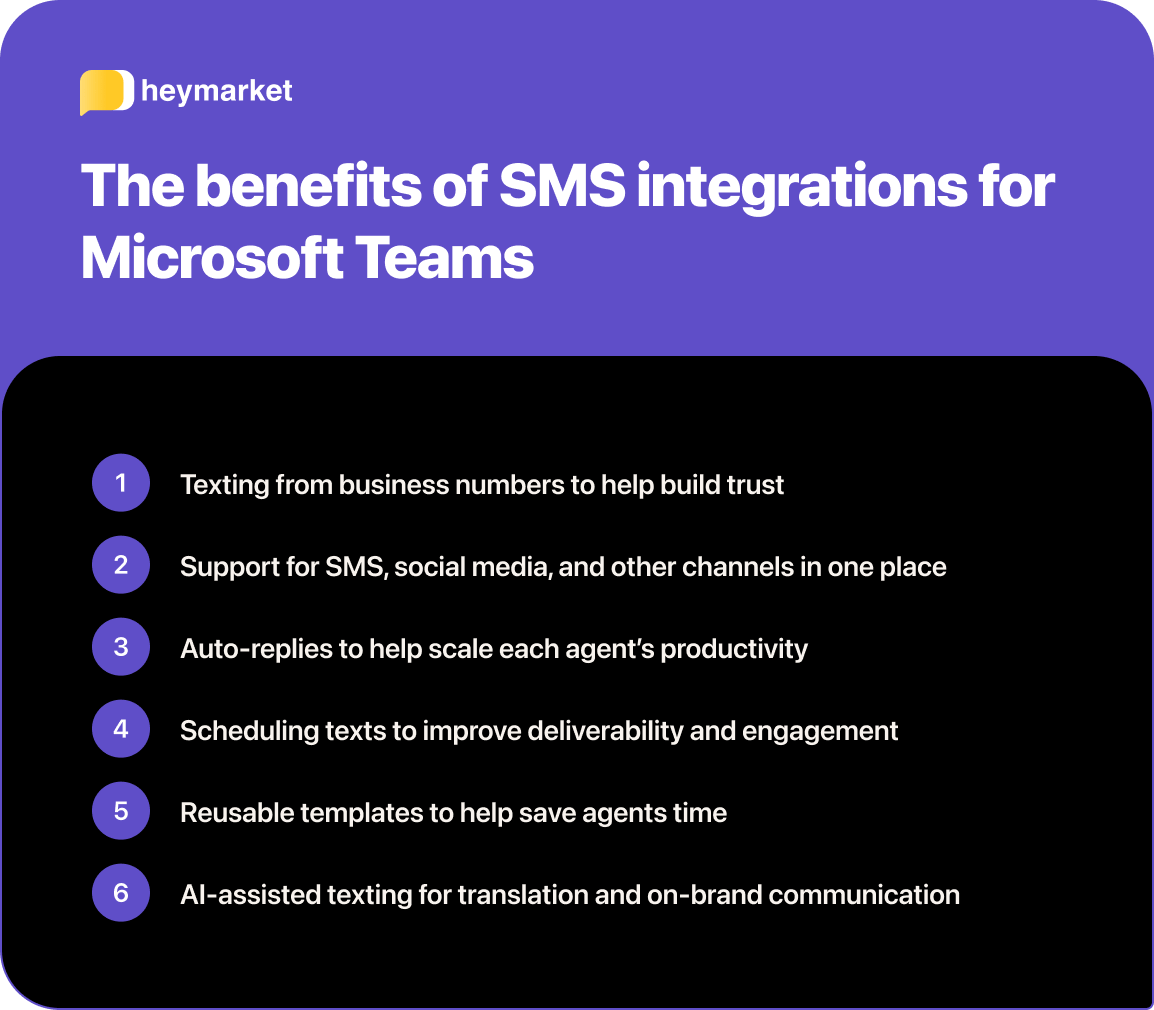
On-brand communication from familiar numbers
With spam texts, scams, and plenty of other reasons to avoid messages from people they don’t know, familiarity is an important part of your customer’s support experience – and that starts with your phone number.
Using an SMS integration lets you text-enable your existing phone or Teams number (or get a new one) instead of texting from shortcodes, minimizing the risk of getting marked as spam or ignored. You’ll also build trust with customers through consistent, branded communication from the same phone number for all their customer service concerns.
Scalable customer service with omnichannel messaging
Great customer service means meeting customers where they are, whether it’s SMS, Facebook Messenger, WhatsApp, or any other text channel. However, trying to stay on top of them all individually makes it hard to provide timely support and can lead to missed messages.
SMS integrations offering omnichannel inboxes allow you to receive and reply to messages from any channel directly from Teams. Your team can see when new messages come in, the channel they’re using, conversation histories, and much more without switching between tabs, windows, or apps, allowing for faster replies at scale.
Automated replies, messages, and campaigns
Some parts of customer service are time-consuming and repetitive, like answering FAQs, welcoming newsletter signups, or reminding clients about upcoming appointments or due dates. These tasks limit the amount of time team members can spend on complex issues that need a human’s problem-solving ability.
Fortunately, when you choose an MS Teams SMS integration with automations, you can streamline the simpler customer service processes to improve your team’s efficiency.
Auto-replies let you automatically respond to incoming messages that have a certain keyword, like “return,” with a pre-built template that answers their question. Alternatively, you can create after-hours replies that say when you’ll be available when someone messages you outside of normal hours.
You can send automated and scheduled texts on a specific day, at intervals before or after an event, or in a sequence for marketing drip campaigns. If you have a new lunch promotion, you can schedule it for noon so it engages customers when they’re most likely to act. If you take appointments, send reminders a week and a day before to avoid no-shows. Or, send review requests a few days after order delivery to gain valuable feedback.
Faster response times with templates and AI assistance
Most customers expect your customer service team to reply to their messages within a minute, so if you want to provide great customer experiences, you need fast response times – and ones that aren’t limited by how quickly team members can type.
Similar to auto-replies, texting integrations for Teams usually offer manual templates you can build and reuse for common cases or lengthy responses, like return or refund policies, asking customers for patience while they do something else, or providing detailed troubleshooting instructions.
Artificial intelligence (AI) can also speed up replies by personalizing or tailoring your texts to fit the context of the conversation. For example, you could use AI-assisted texting to quickly summarize a product description or documentation from the company knowledge base, formalize a message or make it more casual to fit your brand voice, or translate a message to ensure the customer understands correctly.
Best practices for sending texts through MS Teams
Text messages are great customer service and marketing tools, but you need to do them right – no matter what platform you text through.
Here are some tips for sending effective texts with Microsoft Teams SMS.
Always secure opt-ins
You must have permission to text any contact that you send a message to, except when directly responding to an incoming message like a question or request for support. These cases include marketing copy and advertisements, order updates, and most other notifications. To help facilitate this, look for a texting platform with advanced administration controls, including opt-in management.
Use automation tools to save time
One of the major benefits of using a business texting platform for Microsoft Teams messaging is the expanded automations that are available. MS Teams has Power Automate, which allows for some workflow creation with certain triggers and message prompts to boost productivity.
A Microsoft Teams integration like Heymarket allows you to create auto-replies to incoming messages, establish workflows with action and time-based automations that nurture customer relationships, add contacts to lists upon opt-in, and generate reports to help inform your process going forward.
Personalize your texts
If you want your leads and customers to interact with your texts, you need to engage them effectively. Details like the contact’s name, meeting information, customer loyalty status, and other dynamic pieces of data all help to build a better connection and make for a tailored experience that improves satisfaction scores by as much as 20%.
When possible, connect your SMS integration with Salesforce or another CRM as well as MS Teams, so you can access rich customer data for personalization. The right integration will let you insert this data dynamically into conversations and personalized mass texts using custom fields for better engagement.
If you don’t use a business texting solution that allows for custom fields, personalization becomes more difficult for larger SMS lists. However, it’s always worth working to personalize texts where possible.
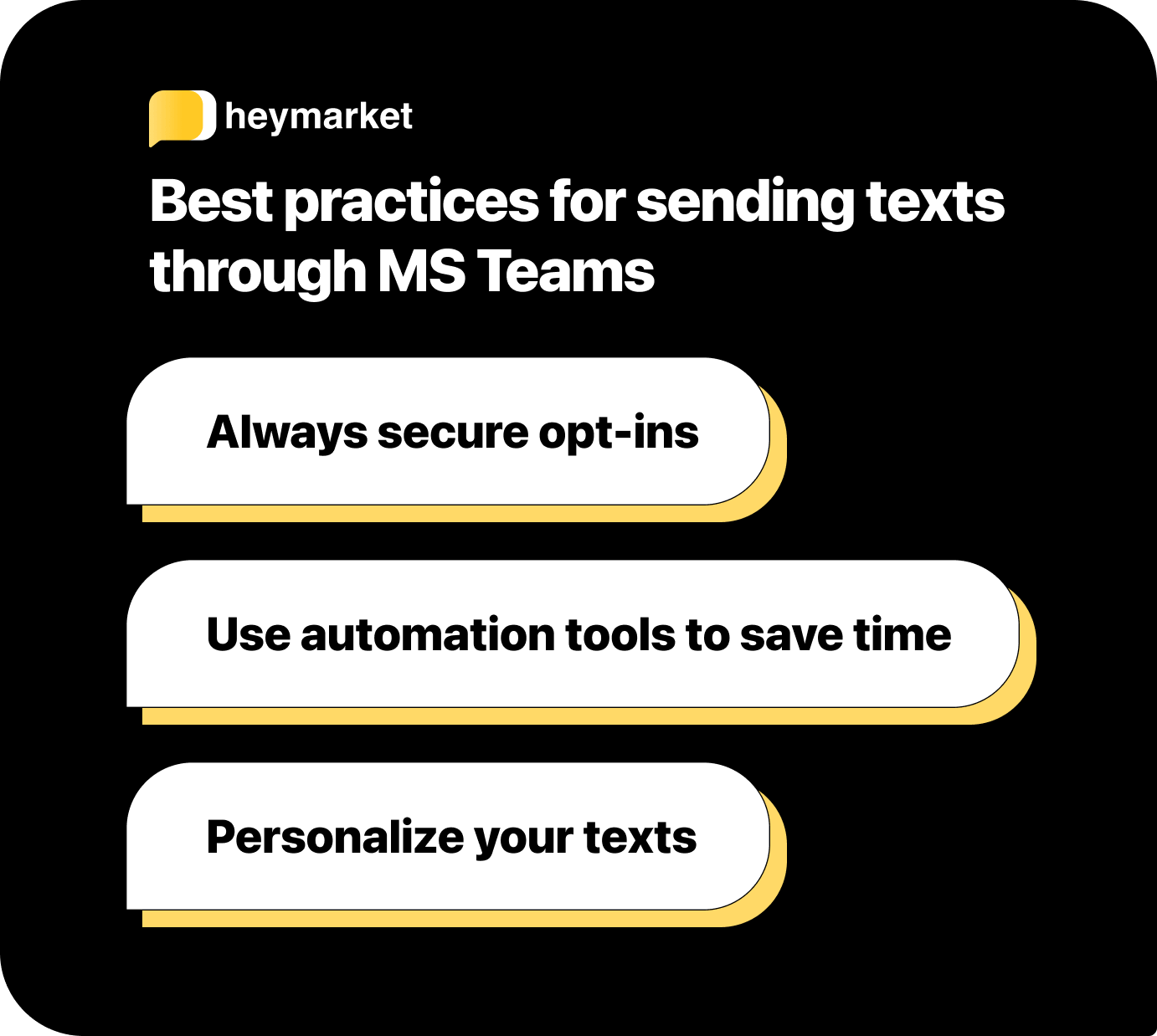
How you can use Microsoft Teams SMS for your business
Adding SMS to Microsoft Teams expands its functionality to more than just internal communication. With an SMS integration like Heymarket, you can use Teams for:
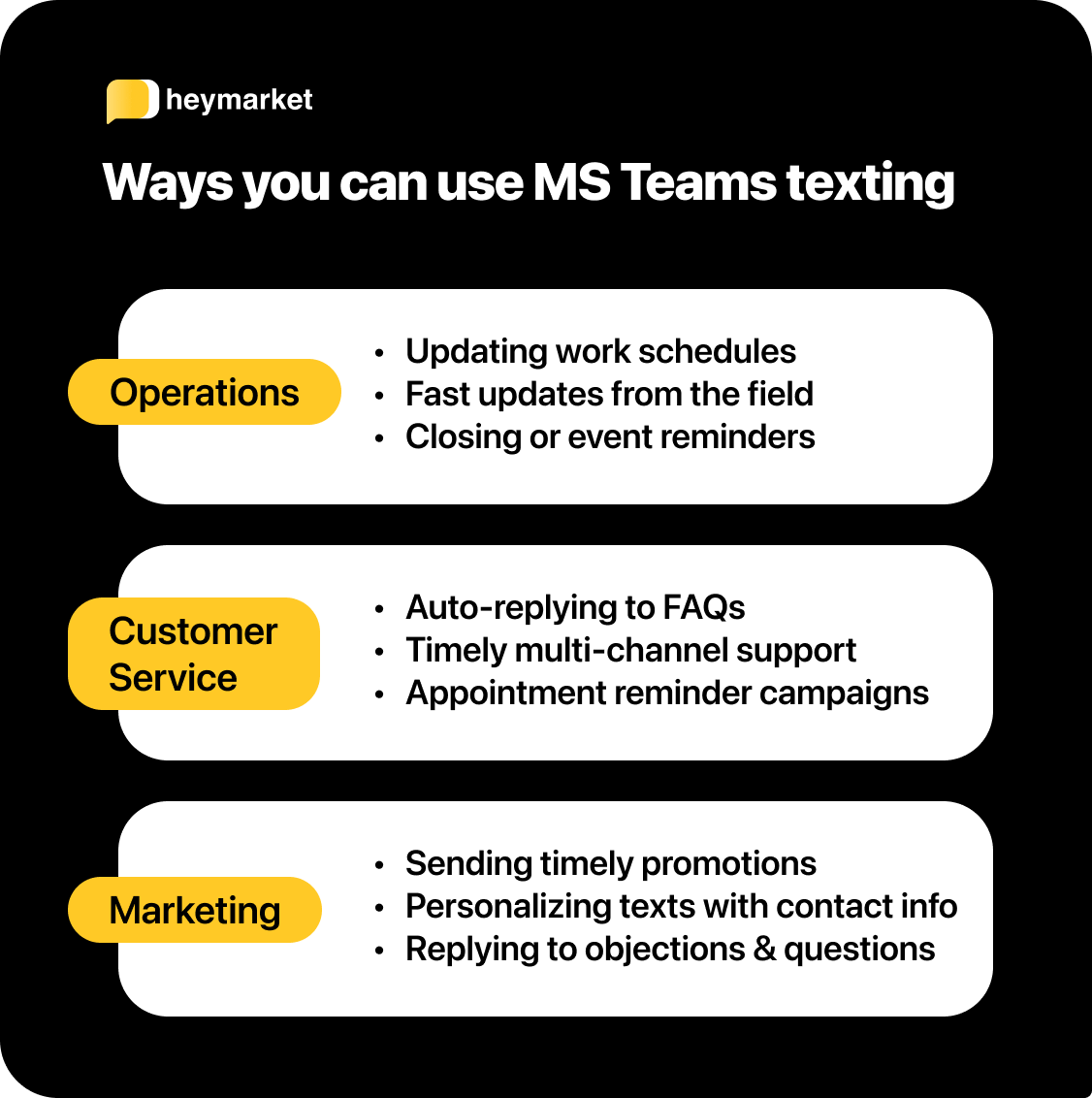
- Operations: If your business works with third-party contractors or team members out in the field, sending texts from Teams via SMS ensures anyone can read your messages and reply quickly to minimize disruptions. Plus, mass texting features let you send notifications about closings, schedule changes, upcoming events, and deadlines in a fraction of the time.
- Customer service: With auto-replies, you can use templates to instantly reply to FAQs and after-hours messages so your team can focus on important cases. Shared inboxes allow your customer service teams to help more customers across all your communication channels, including SMS and social media, from a centralized location. You can also automate texts to create appointment reminders leading up to the date, send important updates, or follow up with customers.
- Marketing: SMS integrations add external communication that’s perfect for outreach, including one-to-one and one-to-many mass marketing texts. You can schedule texts to send at the right time for your audience, segment your texting list based on interests, customer status, and other data to help tailor them for better engagement, and insert custom fields like names to help personalize your messages. If they reply, your agents can answer their questions directly from Teams through two-way conversations.
With SMS for Microsoft Teams, you can do everything Teams already does – and more.
Unlock the full power of Microsoft Teams with a texting integration
Microsoft Teams is a powerful and popular internal communication tool, but it lacks external functionality. And with so many businesses using the app on a regular basis, expanding its capabilities with an SMS integration is a great way to take advantage of that accessibility to help improve teams’ productivity without interfering with the rest of their workflow.
Whether you’re looking to improve your customer service, simplify marketing, or streamline operations with fast communication, texting is a great addition to Microsoft Teams.
While Microsoft took a big step forward when they added Microsoft Teams messaging to Teams, it’s not a comprehensive solution for all business texting purposes. Fortunately, it’s integration-friendly, which allows you to build on what it can do without leaving Microsoft Teams to text.

Want to learn more about sending texts through Microsoft Teams? Explore Heymarket’s Microsoft Teams integration.
Learn More




